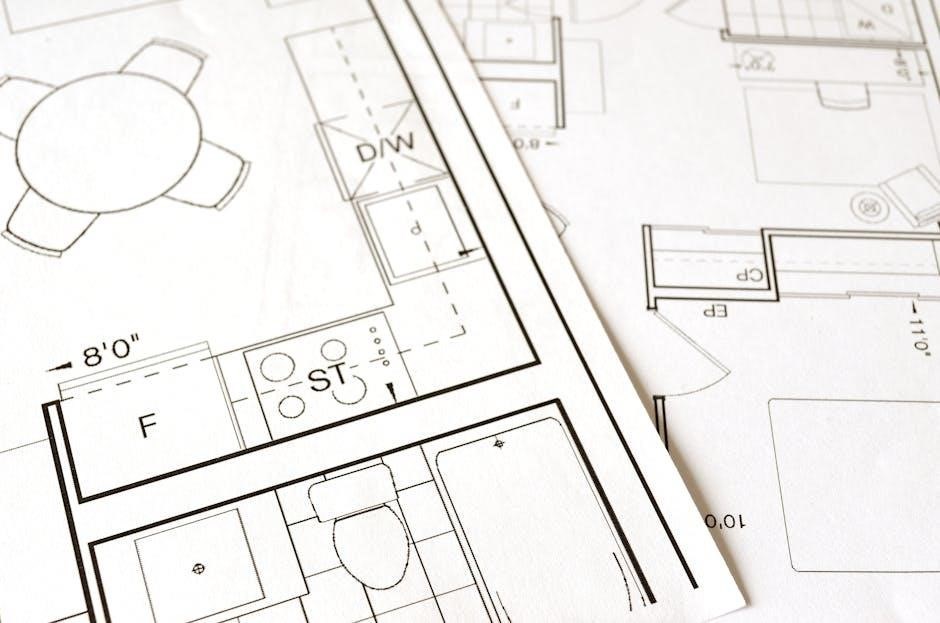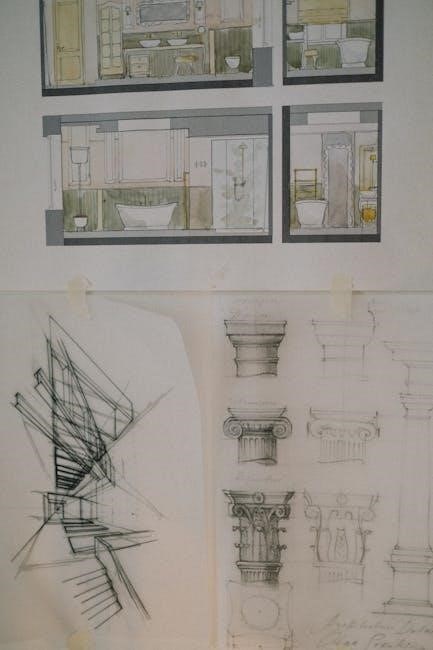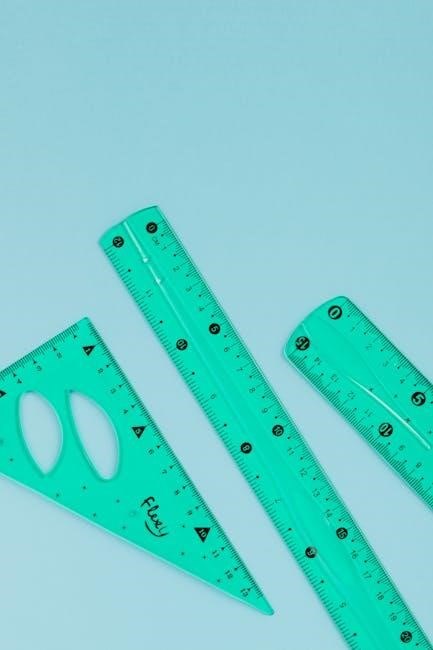Scale drawings are visual representations of objects using a consistent scale, maintaining shape but not size. They are essential for accurately depicting real-world objects in a smaller format, aiding in understanding proportions and ratios. Widely used in architecture, geography, and engineering, scale drawings help students in 7th grade develop math skills through practical, hands-on activities.
Definition and Importance of Scale Drawings
Scale drawings are visual representations of objects using a consistent scale, maintaining shape but not size. They are essential for accurately depicting real-world objects in a smaller or larger format. These drawings are crucial for understanding proportions, ratios, and spatial relationships. Scale drawings are widely used in architecture, engineering, and geography to convey precise measurements and comparisons. They help students develop problem-solving skills and prepare them for real-world applications, making them a valuable educational tool for 7th graders learning math and geometry.
Relevance to 7th Grade Curriculum
Scale drawings are integral to the 7th-grade curriculum, aligning with geometry and measurement standards. They enhance proportional reasoning, a critical math concept, by teaching students to interpret and create scaled representations. Worksheets on scale drawings help students master skills like calculating actual lengths and areas, essential for real-world applications. These activities bridge math with practical problem-solving, making learning engaging and relevant. By incorporating scale drawings, educators ensure students develop a strong foundation in spatial awareness and mathematical precision.

Understanding Scale Factors
Scale factors are ratios used to adjust the size of objects proportionally in drawings. They help maintain shape while scaling up or down, enhancing problem-solving skills for real-world applications.
What is a Scale Factor?
A scale factor is a ratio that describes the relationship between the size of a drawing and the actual object it represents. It determines how much an object is enlarged or reduced in a scale drawing. For example, a scale factor of 1:100 means 1 unit on the drawing equals 100 units in real life; Scale factors are essential for maintaining proportional relationships, ensuring accuracy in representations like maps, blueprints, and architectural designs.
How to Calculate Scale Factors
To calculate a scale factor, compare the drawing measurement to the actual measurement. Divide the drawing length by the actual length to find the reduction factor. For example, if a room is 10 feet wide and 2 inches on the blueprint, the scale factor is 2 inches:10 feet, or 1:60. This ratio ensures all dimensions are proportionally accurate, allowing students to practice real-world applications in math and geometry through various problems and exercises.

Creating Scale Drawings
Creating scale drawings involves determining a scale factor and applying it to accurately represent real-world dimensions. This process enhances spatial reasoning and proportional understanding for 7th-grade students.
Steps to Create a Scale Drawing
To create a scale drawing, start by determining the scale factor, ensuring it fits the available space. Measure the actual dimensions of the object or space. Convert these measurements using the scale factor to get scaled dimensions. Use graph paper to draw accurately, ensuring proportions are maintained. Label the scale clearly for reference. Review and adjust as needed to ensure precision and correctness. This process helps students develop spatial reasoning and proportional understanding effectively.
Practical Examples for 7th Graders
Practical examples include creating a scale drawing of a classroom or room, where 1 cm represents 4 feet. Students can draw a blueprint of their dream bedroom, applying scale factors to ensure accuracy. Another example is designing a park map, scaling down actual distances to fit on paper. These exercises help students apply math to real-world scenarios, enhancing their understanding of proportions and spatial relationships while making learning engaging and fun.

Benefits of Scale Drawings Worksheets
Scale drawings worksheets enhance math and motor skills, improve reasoning, and boost logical thinking. They engage students in hands-on activities, making learning fun while developing essential spatial awareness.
Development of Math and Motor Skills
Scale drawings worksheets enhance math skills by teaching proportions, ratios, and accurate measurements. They also improve motor skills through precise drawing and scaling, fostering creativity and attention to detail. These activities engage students in interactive problem-solving, making learning both effective and enjoyable for 7th graders. By practicing scale conversions and spatial reasoning, students develop a strong foundation in geometry and measurement, essential for higher-level math concepts.
Enhancement of Reasoning and Logical Skills
Scale drawings worksheets sharpen reasoning and logical skills by requiring students to apply ratios, proportions, and spatial awareness. Solving problems involving scale conversions and estimating measurements enhances critical thinking. These activities encourage students to analyze relationships between dimensions, fostering logical reasoning and problem-solving abilities. By interpreting scales and translating them into accurate drawings, students develop a deeper understanding of geometry and its practical applications, preparing them for complex mathematical challenges.

Real-World Applications of Scale Drawings
Scale drawings apply in architecture, engineering, and geography for accurate representations. They aid in creating blueprints, maps, and models, essential for urban planning and large-scale projects.
Architecture and Engineering
Scale drawings are vital in architecture and engineering for creating precise blueprints and models. They allow professionals to visualize structures, ensuring accurate measurements and proportions. Architects use scale drawings to design buildings, while engineers rely on them for constructing bridges and machinery. These drawings help in planning, executing, and communicating complex projects effectively. For example, a house plan uses a scale like 1 inch representing 1 foot, enabling accurate construction. Scale drawings bridge the gap between ideas and real-world applications, making them indispensable in these fields.

Maps and Geography
Scale drawings are essential in maps and geography for representing large areas on a smaller scale. Maps use specific ratios, such as 1 cm representing 1 km, to depict distances accurately. This helps in understanding spatial relationships and proportions. For example, on a map, 7 cm might represent 280 km, allowing users to estimate real-world distances. Scale drawings in geography enable students to visualize and interpret landscapes, making them a fundamental tool for learning about the world’s physical features and locations.

How to Solve Scale Drawing Problems
Understand the scale ratio, use proportions to convert actual measurements to scaled dimensions, and practice with examples to master calculations of lengths and areas accurately.
Converting Actual Dimensions to Scaled Dimensions
To convert actual dimensions to scaled dimensions, determine the scale factor by dividing the model measurement by the actual measurement. Use proportions or unitary methods to maintain accuracy. For example, if a room is 10 feet wide and the scale is 1 inch to 2 feet, divide 10 by 2 to get 5 inches. Always ensure the scale is consistent across all dimensions to maintain the correct proportions in the drawing. Practice with real-world examples, like measuring classroom walls, to build proficiency.
Calculating Actual Lengths and Areas
To find actual lengths from scale drawings, reverse the scale factor by dividing the scaled measurement by the factor. For areas, divide the scaled area by the square of the scale factor. For example, if a room’s width on a blueprint is 5 inches with a scale of 1 inch to 2 feet, the actual width is 10 feet. This skill is essential for real-world applications, such as estimating materials for painting or flooring, and helps students apply mathematical concepts to practical problems.

Common Mistakes and Tips
Common mistakes include misapplying the scale factor and miscalculating measurements. Tips: Double-check the scale ratio, use precise tools, and verify calculations to ensure accuracy in scale drawings.
Understanding the Scale Ratio
A scale ratio compares the drawing’s measurements to the actual object’s measurements. For example, a ratio of 1:10 means 1 unit on the drawing equals 10 units in real life; Students must grasp this concept to interpret and create accurate scale drawings, ensuring proportions remain consistent. Understanding the scale ratio is crucial for solving problems involving scale drawings, as it directly affects all measurements and calculations. Mastery of this skill enhances problem-solving abilities and real-world application accuracy.
Avoiding Measurement Errors
To avoid measurement errors in scale drawings, ensure the scale factor is applied consistently to all dimensions. Double-check conversions between actual and scaled measurements, and use precise tools for accuracy. Labeling dimensions clearly helps prevent confusion. Pay attention to unit consistency, as mixing units can lead to errors. Regularly verify calculations, especially when scaling up or down. By maintaining focus and carefully executing each step, students can create precise scale drawings and avoid common mistakes that distort proportions or misrepresent actual sizes.

Where to Find Scale Drawing Worksheets

Scale drawing worksheets for 7th grade are available on educational websites like Algebra4children.com and MathLinks. Printable PDFs can also be found on platforms like Teachers Pay Teachers and Google Classroom.
Recommended Online Resources
For 7th-grade scale drawing worksheets, recommended online resources include educational platforms like Khan Academy and GeoGebra. These websites offer interactive tools and guided lessons to help students master scale drawings. Additionally, Teachers Pay Teachers provides a variety of printable PDF worksheets tailored for middle school math curriculum. These resources are designed to engage students with real-world applications, ensuring a deeper understanding of scale factors and their practical uses in geometry and everyday problem-solving activities.
Printable Worksheets for Practice
Printable worksheets for 7th-grade scale drawings are widely available online, offering structured exercises to practice creating and interpreting scale drawings. Platforms like Teachers Pay Teachers and MathLinks provide downloadable PDFs with activities such as drawing arrows to scale, calculating actual dimensions, and applying scale factors to real-world problems. These worksheets are designed to reinforce understanding of geometric concepts and help students master scale drawing skills through hands-on practice, making learning engaging and effective for middle school math curriculum.
